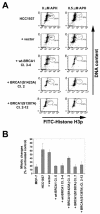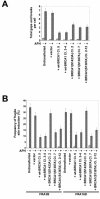BRCA1 is required for common-fragile-site stability via its G2/M checkpoint function
- PMID: 15254237
- PMCID: PMC444841
- DOI: 10.1128/MCB.24.15.6701-6709.2004
BRCA1 is required for common-fragile-site stability via its G2/M checkpoint function
Abstract
Common fragile sites are loci that form chromosome gaps or breaks when DNA synthesis is partially inhibited. Fragile sites are prone to deletions, translocations, and other rearrangements that can cause the inactivation of associated tumor suppressor genes in cancer cells. It was previously shown that ATR is critical to fragile-site stability and that ATR-deficient cells have greatly elevated fragile-site expression (A. M. Casper, P. Nghiem, M. F. Arlt, and T. W. Glover, Cell 111:779-789, 2002). Here we demonstrate that mouse and human cells deficient for BRCA1, due to mutation or knockdown by RNA interference, also have elevated fragile-site expression. We further show that BRCA1 functions in the induction of the G(2)/M checkpoint after aphidicolin-induced replication stalling and that this checkpoint function is involved in fragile-site stability. These data indicate that BRCA1 is important in fragile-site stability and that fragile sites are recognized by the G(2)/M checkpoint pathway, in which BRCA1 plays a key role. Furthermore, they suggest that mutations in BRCA1 or interacting proteins could lead to rearrangements at fragile sites in cancer cells.
Figures






References
-
- Arlt, M. F., D. E. Miller, D. G. Beer, and T. W. Glover. 2002. Molecular characterization of FRAXB and comparative common fragile site instability in cancer cells. Genes Chromosomes Cancer 33:82-92. - PubMed
-
- Casper, A. M., P. Nghiem, M. F. Arlt, and T. W. Glover. 2002. ATR regulates fragile site stability. Cell 111:779-789. - PubMed
-
- Cha, R. S., and N. Kleckner. 2002. ATR homolog Mec1 promotes fork progression, thus averting breaks in replication slow zones. Science 297:602-606. - PubMed
Publication types
MeSH terms
Substances
Grants and funding
LinkOut - more resources
Full Text Sources
Other Literature Sources
Molecular Biology Databases
Miscellaneous
